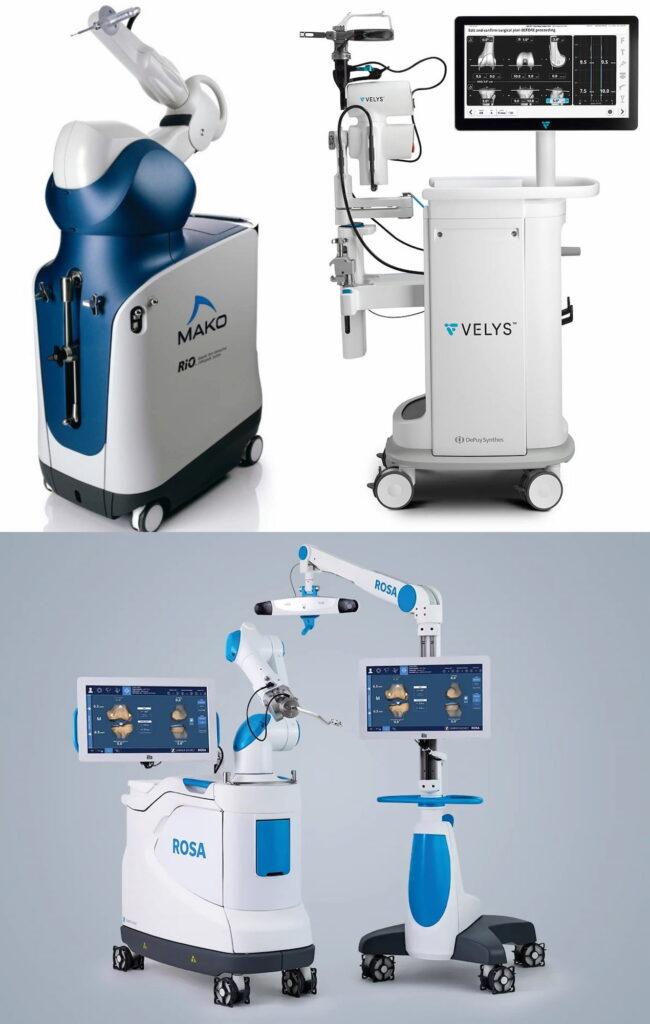Robotic-assisted joint replacement surgery is an option for patients with arthritis considering an operation. By allowing for a more targeted approach, it improves the accuracy of performing joint replacements, resulting in less overall tissue damage and more reliable component positioning. There are a range of applications:
What the surgery involves
Using advanced robotic technology, Dr Lambers maps out and executes a precise plan tailored to each patient’s anatomy. This targeted replacement reduces trauma to the surrounding tissues, promoting a quicker recovery and maintaining more of the hip or knee’s natural movement patterns.
The robotic assistance aids in aligning and positioning the implant with high accuracy, with the aim of improving the prosthetic joint’s long-term functionality and lifespan. Dr Lambers uses the MAKO robotic system made by Stryker, however there are several robotic systems now available in Australia as shown below. A patient guide on robotic surgery from the UK can be found below which outlines some of the risks and benefits of robotics to patients.

What to expect after surgery
After robotic joint replacement surgery, patients can expect to begin walking the same day, often with the aid of crutches or a walker for additional support. Early recovery focuses on regaining mobility, reducing pain, and restoring muscle strength. Physical therapy and a structured exercise program are essential components of recovery, helping to ensure optimal joint function and flexibility.
While every recovery timeline is unique, many patients experience significant improvement within the first two months, often reporting better function and reduced pain compared to their pre-surgery condition. Full recovery and maximum benefit from the surgery can take six to twelve months as the body takes time to fully adapt to the new joint.
Read the full post-operative rehabilitation protocols below:
How long will the hospital visit be?
Most patients stay in the hospital for one to three nights following a robotic-assisted replacement procedure. This time allows for initial recovery and ensures that patients receive appropriate postoperative care, including pain management, monitoring for potential complications, and assistance with walking.
Are there any additional risks in using a robot?
The only additional surgical step is placing thin pins in the bones to guide the robotic alignment. These have the potential to get infected or cause a break of the bone, which is an additional risk, though this is rare.
In a knee replacement there are 2 additional 1cm cuts below the main wound for these pins. In hip replacement these are located on your upper outer hip bone near where a belt may sit that is a little sore for 2 weeks and can rub on clothing. Read more about the symptoms of this in one of Dr Lambers’ research studies below:
There is also the unlikely event of a technical error with the robotic machine that means the surgery can no longer be completed using the robot. Depending on which stage of the procedure this occurs your surgery can either be finished using manual instruments, or needs to be paused and postponed until a day and time that the issue has been rectified.
Recovery timeline
Many patients find they can resume daily activities, like walking and driving, within a few weeks post-surgery, depending on the leg operated on and the type of vehicle they drive. Within two to three months, most patients can comfortably perform many of their regular tasks, though the full recovery period may extend to a year for the joint to reach peak functionality and comfort. Continuous exercise and rehabilitation play a crucial role in maintaining strength and flexibility throughout recovery.
Do I need private health insurance?
No, fortunately both the public (Northeast Health Wangaratta) and private (Wangaratta Private Hospital) hospitals that Dr Lambers operates at have acquired sophisticated robot technology and were one of the first regional centers to do so. Dr Lambers performs robotic knee and hip replacement surgery at both the private and public hospitals.
Discussing surgery with Dr Lambers
The decision to undergo joint replacement surgery is a personal one, and it is important to take the time you need to fully understand your options. If referred to Dr Lambers, the first conversation will be about whether or not a joint replacement aligns with your health goals and lifestyle. Dr Lambers will answer any questions and support you in making the choice that’s right for you.

